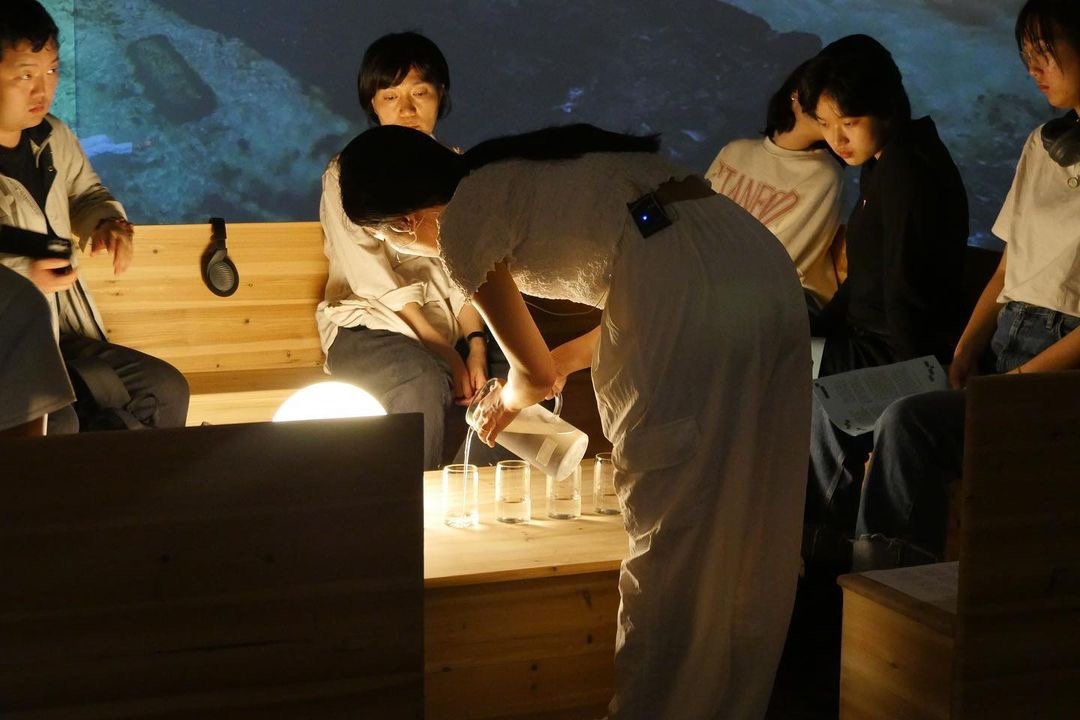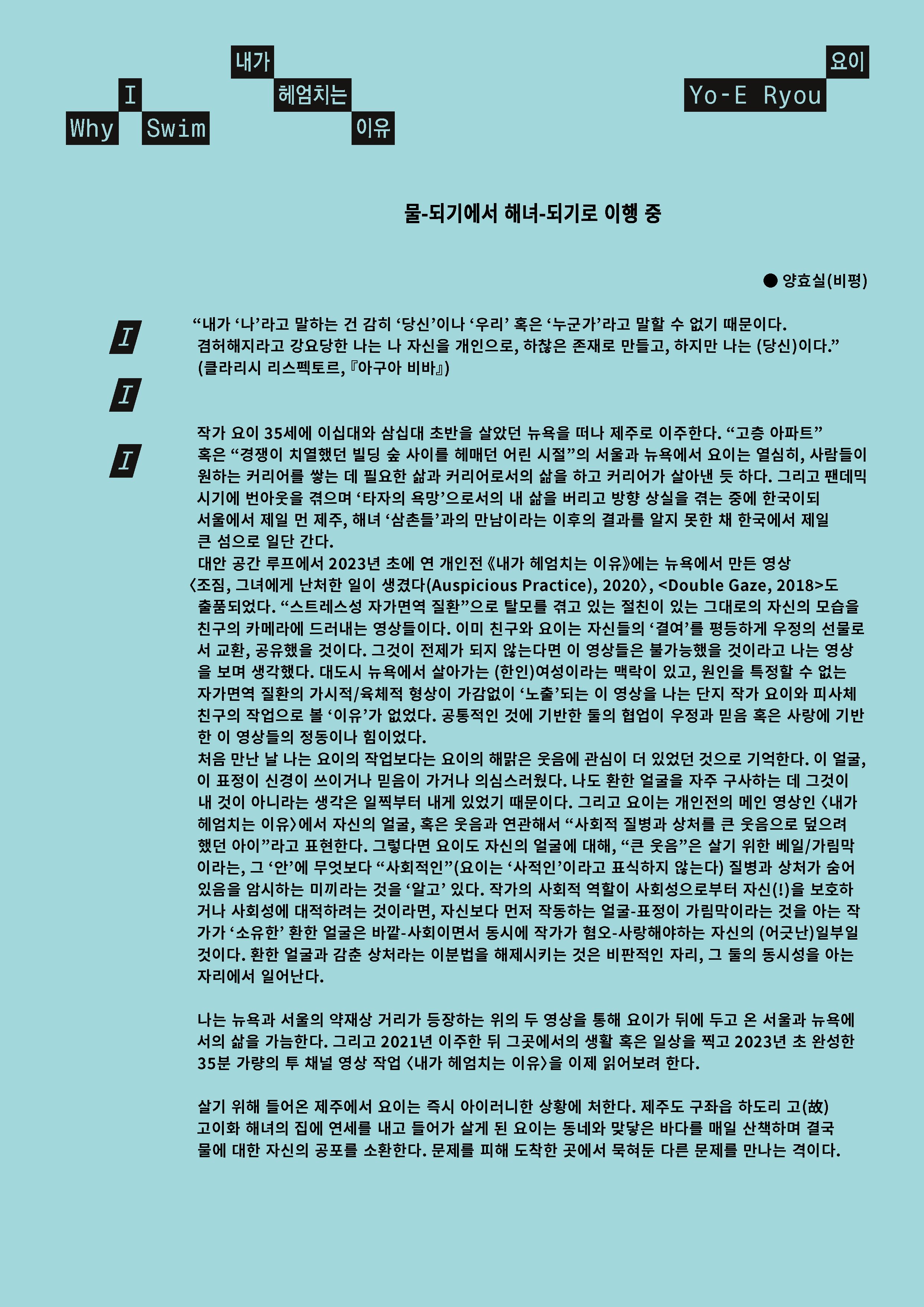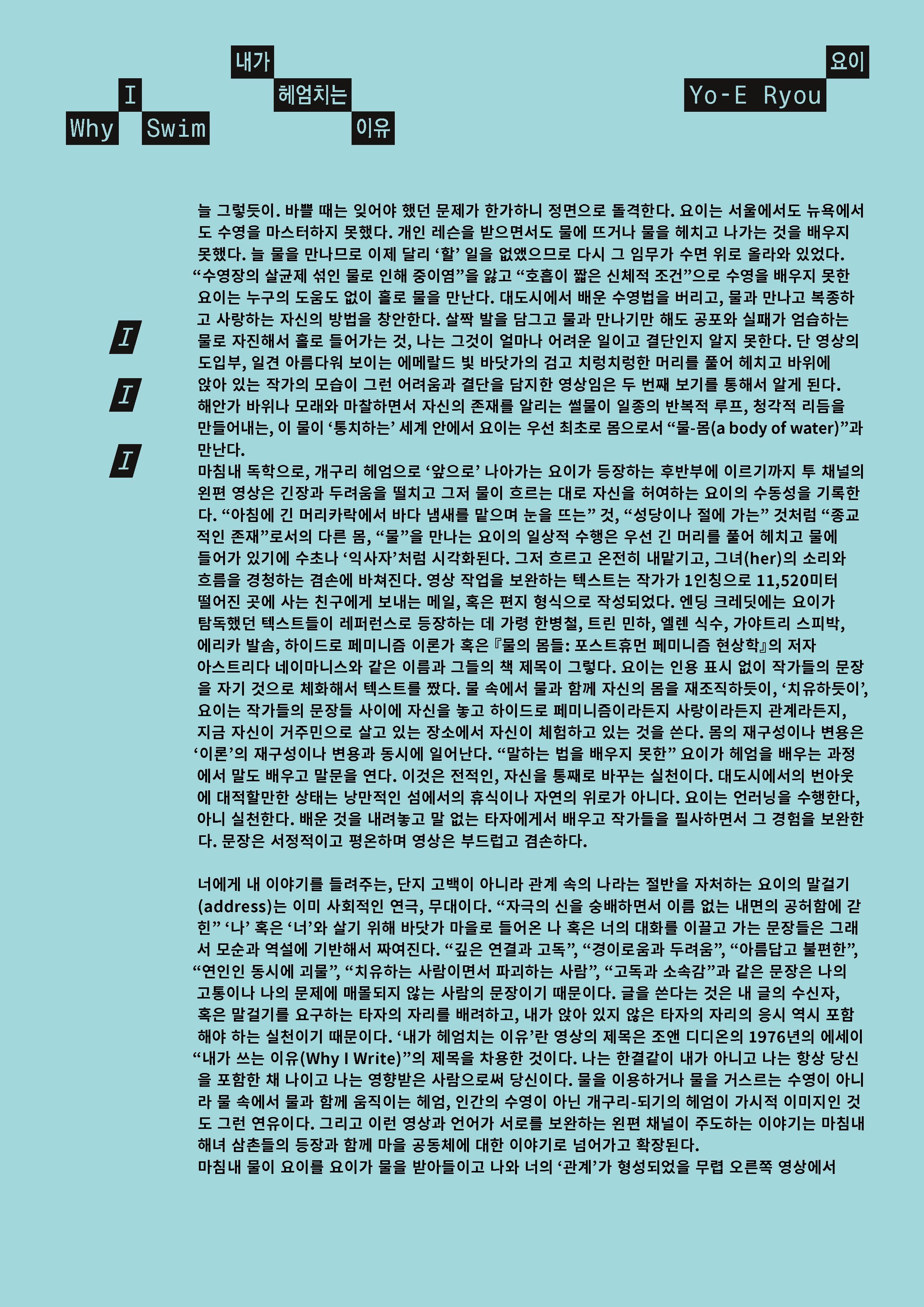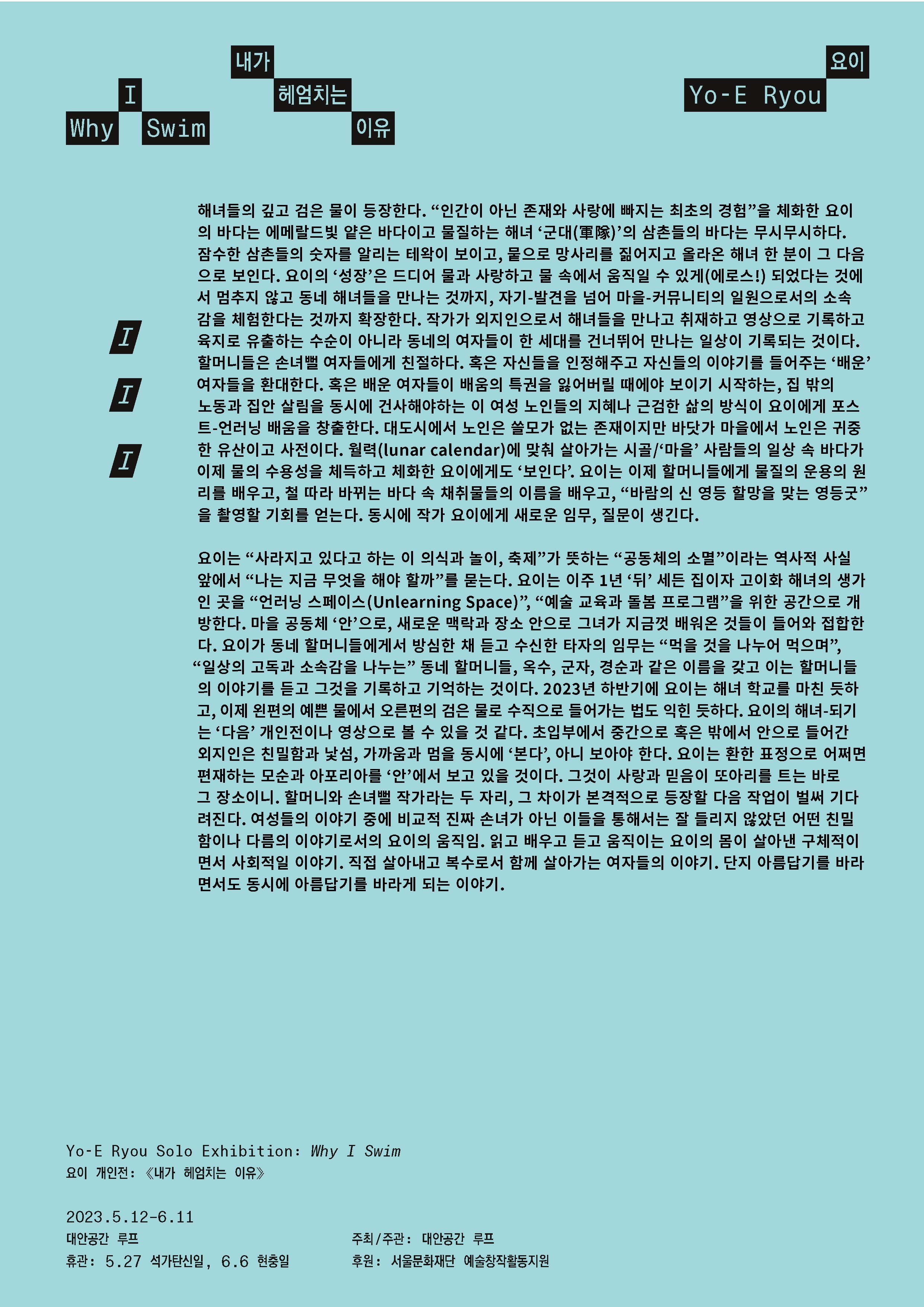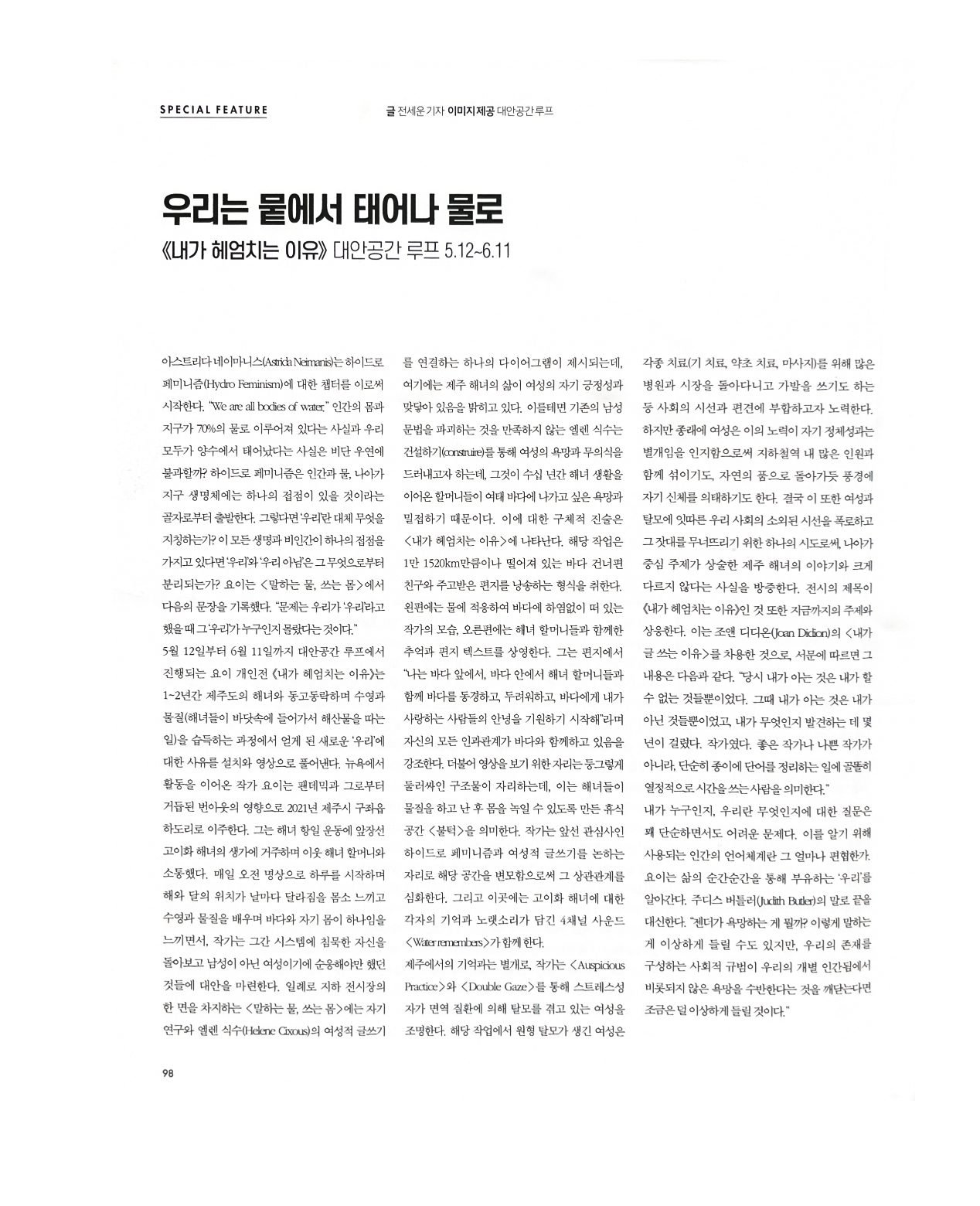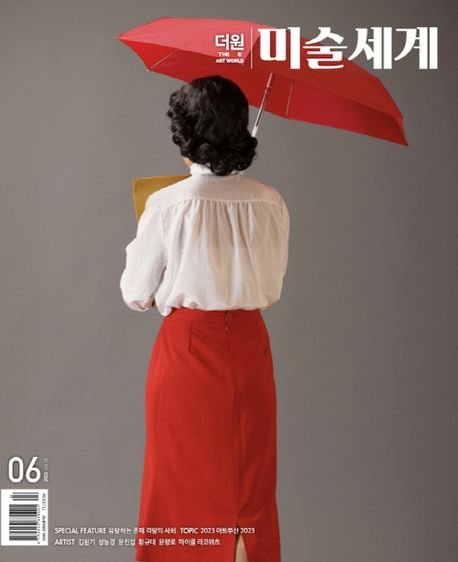Yo-E Ryou, Why I Swim, two channel video, sound, 34min 36sec, 2023
요이, 내가 헤엄치는 이유, 2-채널 영상, 사운드, 34분 36초, 2023
Yo-E Ryou Solo Exhibition: Why I Swim
2023/05/12 – 2023/06/11
Opening Reception : 5pm, May 12th(Fri) / Reading Performance: 6pm, May 12th(Fri) / Hydrofeminism and Women’s Writing Workshop: 7pm, May 19th(Fri) / 7pm, June 2nd(Fri)
Artist’s Talk: 7pm, June 9th(Fri)
Presented/Organized by Alternative Space LOOP, Sponsored by Seoul Foundation of Arts and Culture, Credits: Design: Shin Shin | Sound: Heejin Jang | Text: Libby Mislan | Carpentry: Gareth Green | Media: Yongkuk Ryou | Installation: Donghae Seo, Jaeyoung Shin | Critic: Hyo-sil Yang, Chus Martinez
요이 개인전: 내가 헤엄치는 이유
2023/05/12 – 2023/06/11
오프닝: 5월 12일(금), 오후 5시 / 리딩 퍼포먼스: 오후 6시
하이드로 페미니즘과 여성적 글쓰기 워크숍: 5월 19일(금), 오후 7시 / 6월 2일(금), 오후 7시
아티스트 토크: 6월 9일(금), 오후 7시
주최/주관: 대안공간 루프 후원: 서울문화재단 예술창작활동지원 크레딧: 디자인신신 | 사운드 장희진 | 글_리비 미슬란 | 목공_가레스 그린 | 미디어_유용국 | 설치_서동해, 신재영 | 비평_양효실
Yo-E Ryou, Bulteok, 4-channel sound installation, cedar wood assembled, 3x2.4x0.8m, 2023
요이, 불턱, 설치물 내 4-채널 사운드 설치, 3x2.4x0.8m, 2023
Yo-E Ryou, Double Gaze, Single channel video, sound, dimension variable, 6min 57sec, 2018
요이, Double Gaze, 단채널 영상, 사운드, 가변크기, 6분 57초, 2018
Yo-E Ryou, The Thousand Hands Sutra, Single channel video, sound, 5min 30sec, 2023
요이, The Thousand Hands Sutra, 단채널 영상, 사운드, 5분 30초, 2023
Yo-E Ryou, Water Speaking, Body Writing, Mixed Material Installation, 1200x3600mm, 2023
요이, 말하는 물, 쓰는 몸, 혼합재료 설치, 1200x3600mm, 2023
After experiencing a pandemic and burnout in New York, Yo-E relocated to Hado-ri, a small village in Jeju in 2021. In the spring of the following year, she opened Unlearning Space in the house where Ko Ihwa haenyeo (female diver of Jeju Island) lived. She initiated an artistic research and care program under the theme of “water, women, and Jeju” and invited local residents and visitors. The exhibition Why I Swim departs from learning how to swim in the sea for the first time in 30 years and delves into the artist’s life experiences with her neighbor haenyeos while running the Unlearning Space.
Double Gaze and Auspicious Practice are video works about a woman suffering from a hair loss due to stress-induced autoimmune disease. The woman and the artist ponder the causes of their physical and mental fatigue and lethargy, as well as the fundamental remedies for burnout. With sparse hair due to circular hair loss, the woman tries treatments such as qi therapy, herbal treatment, and scalp massage in various locations around Seoul. She tries out wigs in an effort to conceal her illness and comply with social stereotypes about how women should look. The artist questions her identity during the journey to find her place and roots in the family, the society and the culture she belongs to.
Water Remembers is a 4-channel sound work about Ko Ihwa, a now deceased haenyeo and activist. The sound of intensifying raindrops, storms, and waves is crescendoing into the mechanical sound of burnout. With the splashing sound of jumping into the water, the neighborhood haenyeos begin to talk about their memories of Ko Ihwa. As they watch a video of one haenyeo, who is well over 80, sings along with the song.
Born in Udo in 1915, Ko Ihwa began harvesting in the sea at the young age of nine. When she was 22, she moved to Hado after getting married. She was the ‘daesanggun,’ the top-ranked haenyeo, received Jeju’s 1st Haenyeo Award for leading the anti-Japanese movement of haenyeos, and was active as the oldest haenyeo in Jeju. The haenyeos in the neighborhood remembered Ko Ihwa as a warm-hearted person who would help making tewaks (lifebuoys) and mangsaris (fishnets) for haenyeos who were not good at making them and put a few conch shells in the mangsaris of haenyeos with low yields. As a drop of rainwater that seeps into one’s body turns into tears, and as we jump into the sea again after being born in amniotic fluid, haenyeos pass down their memories and stories, creating another connection. The artist is loosely weaving together a soundscape of personal narratives from undocumented stories she gathered.
The title of the exhibition, “Why I Swim,” was borrowed from Joan Didion’s essay “Why I Write,” published in 1976. Didion wrote; “All I knew then was what I couldn’t do. All I knew then was what I wasn’t, and it took me some years to discover what I was. Which was a writer. By which I mean not a “good” writer or a “bad” writer but simply a writer, a person whose most absorbed and passionate hours are spent arranging words on pieces of paper.” The 2-channel video work Why I Swim is based on the artist’s experience of learning to swim in the sea in Jeju. It takes the form of a letter written between friends across the ocean. It is a poetic letter about herself, who learned to speak and swim, breaking through her struggles as a teenager with the social pressures and a long silence followed by burnout.
Yo-E’s artistic practice is closely connected to her research on hydrofeminism. The Earth and human beings are composed of 70% water, and humans have lived in amniotic fluid from the time of fetal stage. Hydrofeminism sees humans as beings connected to other organisms on Earth through the water rather than as distinct individuals. By interacting with the haenyeos in her neighborhood, the artist explores the special relationship between the haenyeos’ bodies and the bodies of water. She helps with the daily tasks of a woman who lives alone and still works as a haenyeo in her 80s. As the haenyeo teaches Yo-E the indigenous ways of how her body is connected to the sea, the artist begins to break away from the Western education system and customs that she had been pushed to adapt to.
Bulteok is an installation that takes inspiration from the resting area built with lava rocks of Jeju, where haenyeos change their clothes, take shelter from the wind, and take a break around the fire. It is also a space where the haenyeos discuss and makes communal decisions on their work and the daily operations of their community. During the exhibition and programmes, the artist will use it as a platform to ask questions about our relationship with water from the lens of hydrofeminist ethics and experiment with various methods of Women’s writing (Écriture féminine) proposed by Hélène Cixous with the visitors. The artist proposes another kind of Bulteok space where one can both reflect in solitude and experience solidarity.
Written by Ji Yoon Yang
Director, Alternative Space LOOP
Translated by Eunsoo Yi
2021년 뉴욕에서 팬데믹과 번아웃을 경험한 작가 요이는 제주시 구좌읍 하도리로 이주한다. 다음 해 봄 고이화 해녀가 살았던 집에서 언러닝 스페이스를 시작한다. ‘물, 여성, 제주’를 주제로 하는 예술 교육과 돌봄 프로그램을 지역 주민과 방문객들과 함께 진행한다. 전시 <내가 헤엄치는 이유>는 작가가 30년 만에 처음으로 바다에서 헤엄치는 법을 배우고 언러닝 스페이스를 운영하며 이웃 해녀 할머니에게 배우는 삶의 경험에서 출발한다.
Double Gaze와 Auspicious Practice는 스트레스성 자가 면역 질환으로 인해 탈모를 겪고 있는 여성에 관한 영상 작업이다. 이 여성과 작가는 스스로 느끼는 신체적, 정신적 피로감과 무기력함, 번아웃의 근원과 근본적 치유에 대해 질문한다. 원형 탈모로 인해 듬성듬성한 머리를 한 채 여성은 기 치료, 약초 치료, 마사지 등 다양한 치료를 서울 곳곳에서 시도한다. 제 질병을 감추기 위해, 여성의 외적 모습에 대한 사회적 편견에 맞추어 가발을 쓰기도 한다. 작가는 제 가족, 자신이 속한 사회와 문화, 자연 생태계에서 살아가는 제 위치와 뿌리를 찾아가며, 제 정체성에 대해 질문한다.
Water remembers는 고이화 해녀에 관한 4-채널 사운드 작업이다. 한 방울씩 떨어지는 빗소리가 모여 파도 소리가 되고, 거세지는 빗물과 폭풍우, 거대한 파도의 사운드가 더해져 꽉 차인 기계적인 번아웃 상태의 사운드로 전환된다. 제 몸을 풍덩 바다에 던지는 사운드와 함께 동네 해녀 할머니들은 고이화에 관한 제 기억을 말하기 시작한다. 고이화가 노래를 부르는 영상을 보면서, 여든이 훌쩍 넘은 해녀 할머니가 그 노래를 따라서 부르는 사운드가 더해진다.
1915년 우도에서 태어난 고이화는 아홉 살 때부터 물질을 시작해서 스물두 살 때 결혼해 하도리로 이주했다. 해녀 군軍 중에서 최고인 ‘대상군’이었고, 해녀 항일 운동을 하여 제주 1호 해녀상을 받았고, 제주의 최고령 해녀로 활동했다. 동네 할머니들이 기억하는 고이화는 테왁/망사리를 잘 못 만드는 해녀에게 대신 만들어 주고, 물질 못하는 해녀에게는 망사리에 소라 몇 개를 넣어주던 정 많은 인물이었다. 빗물 한 방울이 내 몸에 스며들어 다시 눈물이 되어 흐르고, 양수에서 태어나 다시 바다에 뛰어들 듯, 이웃 해녀 할머니들은 그들의 삶과 기억을 전하며, 또 다른 연결을 만들어 낸다. 공식적인 기록에 남아있지 않은 그의 개인 서사를 느슨하게 엮어낸다.
전시 제목 ‘내가 헤엄치는 이유’는 조앤 디디온이 1976년에 쓴 글 <내가 글 쓰는 이유>를 차용했다. 조앤 디디온은 말한다. “당시 내가 아는 것은 내가 할 수 없는 것들뿐이었다. 그때 내가 아는 것은 내가 아닌 것들뿐이었고, 내가 무엇인지 발견하는 데 몇 년이 걸렸다. 작가였다. 좋은 작가나 나쁜 작가가 아니라, 단순히 종이에 단어를 정리하는 일에 골똘히 열정적으로 시간을 쓰는 사람을 의미한다.” 2채널 영상 작업 <내가 헤엄치는 이유>는 제주에서 바다 수영을 배우는 작가의 경험을 바탕으로 한다. 바다 건너편의 친구에게 편지를 쓰는 형식을 갖는다. 입시 경쟁에 시달린 십 대, 오랜 번아웃의 상황과 침묵을 깨고, 말하는 법과 헤엄치는 법을 배우는 나 자신에 관한 서정적인 편지다.
요이의 예술 실천은 하이드로 페미니즘에 관한 작가의 연구와 맞닿아 있다. 지구와 인간은 70%의 물로 구성되며, 인간은 태아 때부터 양수 속에서 살았다. 지구의 물이 어디에서 왔는지에 관해서 과학적으로 증명된 바가 없다. 하이드로 페미니즘은 인간을 개별적 존재가 아닌, 물과 함께 지구의 다른 생명체와 연결된 존재라 본다. 작가는 이웃에 사는 해녀 할머니들과 교류하며 그들의 몸과 바다 사이의 특별한 관계를 탐구한다. 작가는 80대에 혼자 살며 여전히 물질을 함께 하는 해녀 할머니의 일상을 돕는다. 해녀 할머니는 제 몸이 바다와 연결되는 토착적 방식을 요이에게 가르쳐 줌으로써, 작가는 제가 강요받았던 서구식 교육과 관습에서 벗어나기 시작한다.
설치 작업 <불턱>은 물질을 하면서 옷을 갈아입거나, 바람을 피해 불을 쬐며 쉬는 제주 바닷가에 있는 불턱 공간을 모티브로 한다. 해녀 공동체 생활에 필요한 정보와 작업을 의논하고 결정하는 공간이기도 하다. 이곳에서 하이드로 페미니즘 관점에서 물과 나의 관계를 질문하고, 엘렌 식수가 제안한 여성적 글쓰기의 다양한 방법을 관객과 함께 실험할 것이다. 고독한 사유의 시간과 여성적 연대의 시간을 경험할 수 있는 또 다른 불턱을 전시를 통해 제안한다.
글: 양지윤, 대안공간 루프 디렉터









